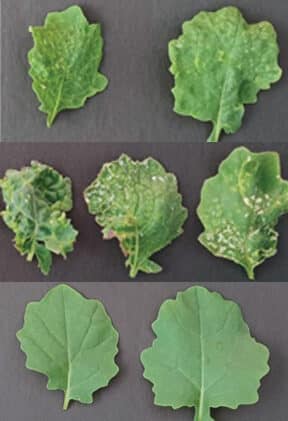Key Result
Researchers discover Resistance: Avirulence protein interactions between the S. sclerotiorum pathogen and canola plants. These interactions open the door to effector-guided breeding where one can select or engineer lines that no longer produce the corresponding necrosis-inducing protein receptor and are, therefore, immune to its effect.
Project Summary
Sclerotinia sclerotiorum, the fungal pathogen that causes sclerotinia stem rot in canola, produces substances that cause lesions on the plant or compromise the ability of the plant to defend itself against attack by the fungus.
In this project, the research team aimed to characterize substances produced by the fungus that cause the characteristic brown, necrotic (dead) lesions on the plant or which compromise the ability of the plant to defend itself against attack by the fungus. These substances were used to identify B. napus lines from collections at plant genetic resource centres to find those that are most tolerant or resistant to individual substances. Combining the resistance traits through traditional breeding will accelerate the development of canola varieties with better tolerance or resistance to stem rot.

The specific bbjectives were to:
(1) examine the importance and mechanisms of action of S. sclerotiorum necrosis-inducing proteins.
(2) identify effectors (secreted proteins and RNA) that S. sclerotiorum emits to suppress host defenses or alter host interactions.
(3) exploit these effectors/necrosis-inducing proteins to identify resistant B. napus cultivars.
Results
Using previous work to sequence the S. sclerotiorum genome, researchers identified 100 candidate genes encoding potential necrosis proteins secreted from S. sclerotiorum.
They then tested these candidate necrosis-inducing proteins on plants. Six of the candidates tested caused necrotic symptoms, thus validating the informatics analysis pipeline. Of the six new S. sclerotiorum necrosis-inducing proteins, five require interaction with a host cell surface receptor. This is similar to classic Resistance:Avirulence protein interactions, like canola has with the blackleg pathogen, for example, however, in this case the interaction of the necrosis-inducing proteins with the host receptor initiates a hyper-sensitive response that leads to necrosis.
With most other pathogens (viruses, plasmodia and biotrophs that cause diseases, such as clubroot and blackleg) the Resistance:Avirulence protein interactions would lead to resistance; however, with S. sclerotiorum the dead tissue provides nutrients to fuel the infection.
The principal investigator says this was an unexpected and exciting discovery. It opens the door to effector-guided breeding where one can select or engineer lines that no longer produce the corresponding necrosis-inducing protein receptor and are, therefore, immune to its effect. To this end, the researchers have now screened a diverse collection of B. napus accessions from AAFC and the Canadian Plant Gene Resources with a necrosis protein found in common in S. sclerotiourum and other canola pathogens. Accessions with reactions ranging from completely resistant to highly susceptible were identified. The genes and mechanisms underlying this phenomenon are under investigation.
Related publication





